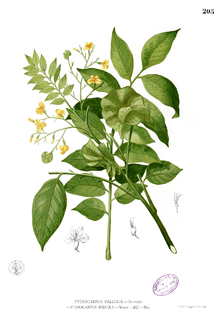Pterocarpus indicus
| Pterocarpus indicus | |
|---|---|
 | |
| Conservation status | |
| Scientific classification | |
| Kingdom: | Plantae |
| (unranked): | Angiosperms |
| (unranked): | Eudicots |
| (unranked): | Rosids |
| Order: | Fabales |
| Family: | Fabaceae |
| Subfamily: | Faboideae |
| Tribe: | Dalbergieae |
| Genus: | Pterocarpus |
| Species: | P. indicus |
| Binomial name | |
| Pterocarpus indicus Willd. | |
| Synonyms[2] | |
| |
Pterocarpus indicus (Amboine, Pashu Padauk, Malay Paduak, New Guinea Rosewood, or, ambiguously, "Narra" which can refer to several Pterocarpus species) is a species of Pterocarpus native to southeastern Asia, northern Australasia, and the western Pacific Ocean islands, in Cambodia, southernmost China, East Timor, Indonesia, Malaysia, Papua New Guinea, the Philippines, the Ryukyu Islands, the Solomon Islands, Thailand, and Vietnam.[3] Other names include Narra (Philippines), Sonokembang (Indonesia), Angsana or Sena (Indonesia, Malaysia and Singapore), Tnug (Cambodia).
Pterocarpus indicus was one of the two species (the other being Eysenhardtia polystacha) used as a source for the 16th to 18th-century traditional diuretic known as lignum nephriticum.[4]
Many populations of Pterocarpus indicus are seriously threatened. It is extinct in Vietnam and possibly in Sri Lanka and the Peninsular Malaysia.[1]
Description
It is a large deciduous tree growing to 30–40 m tall, with a trunk up to 2 m diameter. The leaves are 12–22 cm long, pinnate, with 5–11 leaflets, the girth is 12-34 m wide. The flowers are produced in panicles 6–13 cm long containing a few to numerous flowers; flowering is from February to May in the Philippines, Borneo and the Malay peninsula. They are slightly fragrant and have yellow or orange-yellow petals. The fruit is a semiorbicular pod 2–3 cm diameter, surrounded by a flat 4–6 cm diameter membranaceous wing (wing-like structure) which aids dispersal by the wind. It contains one or two seeds, and does not split open at maturity; it ripens within 4–6 years, and becomes purple when dry. The central part of the pod can be smooth (f. indica), bristly (f. echinatus (Pers.) Rojo) or intermediate.[5][6]
Most Pterocarpus species prefer seasonal weather but P. indicus prefer rainforests.
Note: Pterocarpus macrocarpus, a similar species native to Burma, is referred to as "Rosewood" throughout South East Asia. P. macrocarpus, is usually harder than P. indicus. When in burl form both are referred to as Amboyna Burl.
Uses
The hardwood, which is purplish, is termite resistant and rose-scented. The wood known in Indonesia as amboyna is the burl of the tree, named after Ambon, where much of this material was originally found. Often amboyna is finely sliced to produce an extremely decorative veneer, used for decoration and in making of furniture and keys on a marimba.
The flower is used as a honey source while leaf infusions are used as shampoos. Both flowers and leaves were said to be eaten. The leaves are supposedly good for waxing and polishing brass and copper. It is also a source of kino or resin.[6]
In folk medicine, it is used to combat tumors.[6] This property might be due to an acidic polypeptide found in its leaves that inhibited growth of Ehrlich ascites carcinoma cells by disruption of cell and nuclear membranes.[citation needed] It was also one of the sources of lignum nephriticum, a diuretic in Europe during the 16th to 18th centuries. Its reputation is due to its wood infusions, which are fluorescent.[4]
The tree is recommended as an ornamental tree for avenues and is sometimes planted in Puerto Rico as a shade and ornament. The tall, dome-shaped crown, with long, drooping branches is very attractive and the flowers are spectacular in areas with a dry season. It is very easily propagated from seed or large stem cuttings, but suffers from disease problems. It is widely planted as a roadside, park, and parking lot tree.
Symbolism
It is the national tree of the Philippines, as well as the provincial tree of Chonburi and Phuket in Thailand.
References
- ↑ 1.0 1.1 World Conservation Monitoring Centre (1998). "Pterocarpus indicus". IUCN Red List of Threatened Species. Version 2012.2. International Union for Conservation of Nature. Retrieved 23 March 2013.
- ↑ "The Plant List: A Working List of all Plant Species".
- ↑ International Legume Database & Information Service: Pterocarpus indicus
- ↑ 4.0 4.1 Muyskens, M.; Ed Vitz (2006). "The Fluorescence of Lignum nephriticum: A Flash Back to the Past and a Simple Demonstration of Natural Substance Fluorescence". Journal of Chemical Education 83 (5): 765. doi:10.1021/ed083p765.
- ↑ Danida Seed Leaflet: Pterocarpus indicus (pdf file)
- ↑ 6.0 6.1 6.2 Purdue University New Crops: Pterocarpus indicus
External links
- Pterocarpus indicus (narra). Images and references - (2006) 17p
- PIER species info: Pterocarpus indicus
| Wikimedia Commons has media related to Pterocarpus indicus. |
| ||||||||||

